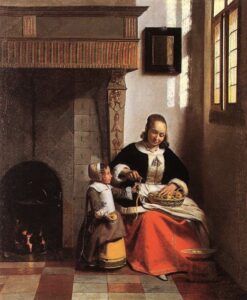Home » England » Robert Irwin » The Limits of Vision
Robert Irwin: The Limits of Vision
Marcia is a British housewife and she has a pathological obsession with dust and dirt in her house. There is no limit to her obsession: dust and rust on the mirror, wax in her ears and earth-like dirt between her toes. She enjoys imagining biological detergent destroying bloodstains on sheets.
That morning she is having a coffee morning so it is out with the vacuum cleaner. But then horror of horrors, it breaks down. Shs thinks of the physics of dust balls as as they romp across the carpet. She sees that the carpet is alive with activity and its undergrowth rich in smells – old socks and mouse-droppings. She even has a conversation with Fungus, the mouthpiece of the dirt. He shows her the horrors of her house. This is your prison; it will be your tomb. The Fungus then tells her that its name is Mucor and is known as such henceforth.

However, it is time for her friends to arrive which they do. Stephanie notices that the breakfast washing-up has not been done. But she also notices the print on the wall – Pieter de Hooch‘s A Woman Peeling Apples (see left). The room shown in the painting is perfectly clean, even though there is an open fire.
But the dirt is still there chez Marcia. She pours honey on the scones she has made and it reminds her of the fungus. Stephanie has a ball of fluff on her skirt. While the others are talking about art, literature and the new vicar, Marcia drifts away.
She is off to the Gobi Desert where Teilhard de Chardin is excavating. He tells Marcia that her skills as a housewife have been invaluable to the expedition. When she drifts back, via Mucor and a strange forest, she challenges her friends: We sit talking about big things that are false to our experience of life – you know, art, religion and so forth, things that really belong to men. Whereas all day every day, what I am actually doing is folding blankets, washing up and things. They are shocked and even more so when she shows them how to wash up and has and almost mystical experience while doing so.
She will later have a bath with Leonardo da Vinci, chat to the Woman Peeling Apples in the de Hooch painting, talk to William Blake and listen to his poem (What is the Hoover but the breath of Man?), meets the Brothers Karamazov, including the fifth brother, Mucor Karazamov, and even hang out with Charles Darwin and Dickens (helping to find a suitable ending for The Mystery of Edwin Drood). Can these great brains solve her cleaning problems? Or is she going mad? And what does husband Philip think about her behaviour?
What looked like being the straightforward story of a woman obsessed with keeping a clean house morphs into a strange but most original and often very witty parody of life and thought in everyday English suburbia with an ending that you will not have vaguely guessed. As always Robert Irwin produces something different from the norm.
Publishing history
First published in 1986 by Viking Books